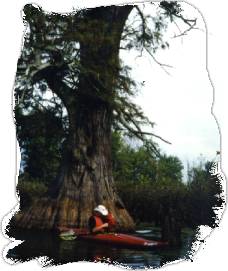- Home
- Go Paddle
- Trip Finder
- Cache River St. Natural Area in Illinois
Trip Overview
 One of Illinois' best-kept secrets is the Cache River State Natural Area - 11,500 acres containing remnant examples of high quality wetlands. Bald cypress and tupelo trees (this is their most northern range) rise majestically from a carpet of intensely green duckweed. Flocks of white egrets and great blue herons greet visitors in the early morning fog along the road to the put-in.
One of Illinois' best-kept secrets is the Cache River State Natural Area - 11,500 acres containing remnant examples of high quality wetlands. Bald cypress and tupelo trees (this is their most northern range) rise majestically from a carpet of intensely green duckweed. Flocks of white egrets and great blue herons greet visitors in the early morning fog along the road to the put-in.
Our group consisted of seven paddlers, including a visitor from Denmark. We camped at Ferne Clyffe State Park, about 20 miles north of the newly installed put-in. There is no car shift for the approximately 6-mile round trip paddle which starts in the swampy part of the river. We saw the State Champion Bald Cypress - over 1000 years old and continued through Eagle Pond with its many cypress trees, one having over 200 knees. The easy trail is marked with international canoe symbols and yellow bands on the trees. It eventually leads to the Cache River itself. We followed the river, which is fairly wide for about a half mile, and then returned to the swamp trail, to ultimately reach the put in again.
We had arranged for an afternoon guided walking tour to Heron Pond with Jim Waycuilis, the IDNR site manager. He surprised us with the announcement that the Cache River State Natural Area had been awarded a state grant of $4 million to build a visitor and education center and that Governor Jim Edgar would be dedicating the site at 1 p.m. Saturday. About 100 people were present at the ceremony. We learned that the Cache River area had been saved from development - speak drainage - by a group of dedicated people who worked for many years to protect this unique Illinois natural resource. Governor Edgar and IDNR Chief Brent Manning both stressed the need for citizen involvement as the best way to obtain government action. This area received its present and future protection as a result of the consistent efforts of a small group of people called the Citizens Committee to Save the Cache.
 The IDNR, The Nature Conservancy, The U.S. Fish & Wildlife Service and Ducks Unlimited are now working together to expand and reclaim the area around the Cache River. This unique environment is also recognized as a Ramsar Site - which is a designation for wetlands of international importance.
The IDNR, The Nature Conservancy, The U.S. Fish & Wildlife Service and Ducks Unlimited are now working together to expand and reclaim the area around the Cache River. This unique environment is also recognized as a Ramsar Site - which is a designation for wetlands of international importance.
The Cache River suffers from many of man's "improvements" - its upper flow is subject to severe erosion due to a diversion cutoff of the river to the Ohio; the lower region, in the swamp is threatened by sedimentation. But it also is the only river that flows in both directions - depending on prevailing water levels elsewhere. After the dedication ceremony, we went on our guided tour to Heron Pond. We walked the floating boardwalk into the swamp and were awestruck by the beauty of the surroundings. Mr. Waycuilis explained the significant efforts needed to save Heron Pond from draining into the upper Cache.
We saw many waterfowl, frogs, and deer, lizards, and a terrified mouse escaping a rat snake. The most wonderful sight probably was on Sunday morning - the thousands of spider-webs strung with diamond pearls of dew on their thin fibers hung between the button-bush branches that grow so extensively in the swamp.
Resources:
This is a magic region - to visit, to hike, to paddle, and to learn from. It is also best enjoyed in small groups. Anyone interested in visiting the area - please call us for the information packet we sent to trip participants, or contact the Cache River State Natural Area, 930 Sunflower Lane, Belknap, IL 62908, 6l8-634-9678.
Do bring some friends along
Canoe rentals are available from White Crane Rentals (237 Dean Lane, Ullin, IL 62902; phone: 618-201-4090)
Trip Details
- Trip Duration: 2-3 Day Trip
- Sport/Activity: Kayaking, Canoeing
- Skill Level: Beginner
- Water Type: River/Creek (Up to Class II)